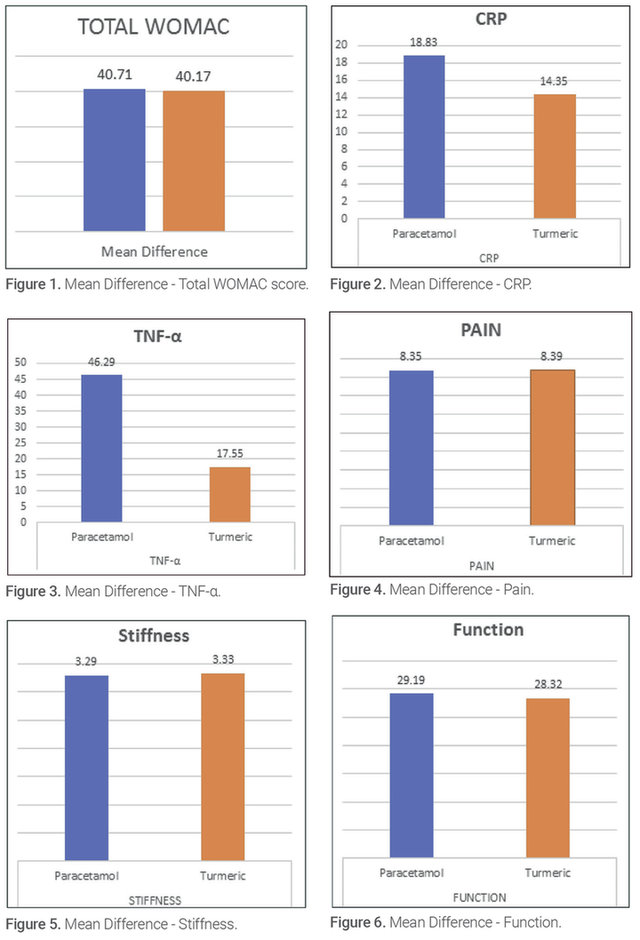CURCUMIN REDUCES KNEE OSTEOARTHRITIS INFLAMMATION AND PAIN*
HEALTHY AGEING

Knee osteoarthritis (OA) is a leading cause of disability among the ageing population. OA is commonly treated with analgesics and non-steroidal anti-inflammatory drugs (NSAIDS), potentially causing gastric side effects. Curcumin, a naturally occurring phytochemical of turmeric, has exhibited anti-inflammatory benefits in various studies, although bioavailability has been an issue in the past. A recent study was conducted comparing the efficacy of a bioavailable turmeric-extract formulation vs. paracetamol in treating knee OA. Pain levels and stiffness were assessed using WOMAC scores and inflammation biomarkers were measured. Results indicated improvement across all WOMAC scores in the curcumin group, comparable to those of the paracetamol group, yet without notable side effects. Serum inflammatory biomarker TNF-α showed a significant reduction in the curcumin group vs. the paracetamol group.
Osteoarthritis (OA) is a painful, degenerative disease, causing breakdown of cartilage, joint lining, ligaments and underlying bone. Approximately 250 million people, globally, suffer from OA, 85% reportedly associated with knee OA (1). OA is one of the 10 most disabling diseases in developed countries, with an estimated 10% of men and 18% of women aged over 60 being symptomatic; 80% of those having limitations in movement; and 25% unable to perform their major daily activities of life (2). Knee osteoarthritis, one of the leading causes of disability and pain in the adult and ageing population, is characterized as pain and stiffness. The increasing prevalence of knee OA has also been attributed to rising rates of obesity.
While all the mechanisms involving knee OA are not fully known, more and more knowledge has come to light in recent years—namely that inflammation is key, as it is in many other diseases including cancer. Pro-inflammatory signals such as prostaglandins, leukotrienes and cyclo-oxygenase-2 are underlying causes of the disease, as are pro-inflammatory cytokines and mediators of their release such as tumor necrosis factor-α (TNF- α); inflammatory interleukins (IL-1, IL-8); nitric oxide synthase; and C-reactive protein (CRP). CRP’s concentration rises in blood plasma in response to inflammation (3).
Traditional treatment of knee OA often includes use of analgesics and NSAIDS. Consistent use of these drugs overtime can result in gastric side effects, ranging from discomfort to stomach ulcers or in extreme cases, organ damage. As such, all-natural, phytochemicals such as curcumin from turmeric (Curcuma longa) that have nutraceutical properties, are being considered as alternative treatment for knee OA and other diseases caused by inflammation.
Curcumin has been shown to inhibit inflammatory biomarkers that have implications beyond arthritis, such as those affecting systemic inflammation leading to Metabolic syndrome— a condition causing systemic issues from hypertension and hyperglycemia to obesity (4). In addition, it has been suggested that curcumin inhibits NF-κB activation, which is a key factor in the chronic inflammatory process that affects diseases such as cancer, cardiovascular disease and other diseases associated with ageing (5).
Although curcumin has proven health benefits, one of the problems shown in past studies has been its bioavailability, including poor absorption, rapid metabolism and rapid systemic elimination. Formulators have applied various approaches to overcome this hurdle, for instance liposomes, micelles, nano particles, piperine etc, (6), have been used to increase bioavailability.
BACKGROUND
In a recent study, the efficacy of a highly bioavailable formulation made of curcuminoids and essential oil of turmeric containing tumerone was evaluated against the efficacy of paracetamol in treating knee OA participants. This study, led by Shuba Singhal, Ph.D., was conducted at the Department of Orthopedics, Lok Nayak Jai Prakash Hospital, associated with Maulana Azad Medical College, New Delhi, and recently published in the Biomed Central journal, Trials (7).
This study is a follow-up to a study conducted in 2019 that reported a positive link between the same bioavailable curcumin formulation and osteoarthritic care. The initial study, using 139 participants, compared the efficacy of the turmeric-extract formula to NSAIDs in the management of knee OA. Three 500mg capsules of turmeric-extract were given to one group, while the other received 50mg NSAID (diclofenac sodium) twice daily. Results showed a significant reduction in pain severity for the turmeric-extract group vs. the NSAID group, and an overall improvement in pain, stiffness, daily living/sports activities and basic quality of life. H2 blockers had to be given to the NSAID group for gastric side effects, but the turmeric-extract group had no such need. As an additional benefit, the turmeric-extract group exhibited a significant reduction in body weight and flatulence (3).
The second study aimed for more clarity and specificity by incorporating an improved scoring methodology and more biomarkers, chiefly TNF-α and CRP.
HIGH-BIOAVAILABLE BCM-95 CURCUMIN’S POSITIVE ROLE IN OSTEOARTHIRITIC CARE
The randomized, non-inferiority controlled clinical study was comprised of 193 patients with knee OA. Participants received either bioavailable turmeric extract (500mg capsules) two-times daily or paracetamol (650mg tablets) three-times daily for six weeks. The turmeric extract capsule contained a combination of curcuminoids (curcumin, demethoxycurcumin, bisdemethoxycurcumin) with essential oil of turmeric rich in ar-turmerone, which makes it more bioavailable (7). Each capsule contained curcuminoids and essential oil complex total not less than 95%, curcuminoids not less than 88%, and curcumin not less than 68%, which was characterized using ultra-performance liquid chromatography and Fourier transform near-infrared (FT-NIR) (7).
Inclusion criteria for participants were as follows: patients with knee osteoarthritis diagnosis based on ACR criteria; between 40-80 years old; patients who had not received analgesics or NSAIDs within 24h; patients with chronic knee pain (i.e., knee pain at least every other day during the month preceding inclusion); patients with radiologic knee osteoarthritis (Kellgren-Lawrence grades 2-4); and patients capable of understanding the study’s instructions (7).
The primary outcome measure was the Western Ontario and McMaster Universities Osteoarthritis Index (WOMAC) pain subscale—a comparison after 6 weeks of treatment between the turmeric group and the paracetamol group. Secondary outcomes measures were WOMAC total, WOMAC stiffness, WOMAC physical function scores and inflammatory markers like CRP and TNF-α. Responder analysis of individual patients at different levels (≥20%, ≥50% and ≥70%) for WOMAC score was calculated and adverse events were recorded (7).
METHODS
After six weeks of treatment, analysis showed a significant improvement in WOMAC scores across all parameters for the turmeric extract group and the paracetamol group. WOMAC scores were equivalent in both groups in all domains (p value < 0.05) (7). In addition, 18% of the turmeric-extract group reported a 50% improvement in pain and function/stiffness scores and 3% reported a 70% improvement. In comparison, none of the paracetamol group received ≥50% improvement in pain, function/stiffness scores (7).
These improvements in symptoms were positively reflected in the turmeric group’s serum inflammatory markers. Results showed that CRP levels in the turmeric-extract group were reduced by 37.21% and TNF-α levels were reduced by 74.81% in comparison to the paracetamol group. The reduction in TNF-α in the turmeric extract group vs paracetamol group was statistically significantly (p = 0.0095) whereas the reduction in the CRP values between the groups was not significant (p > 0.05). (7).
No serious adverse events were reported in either group. Adverse events reported by the paracetamol group totalled 12.68% of group’s patients: restlessness (1.41%), abdominal pain/distention (5.63%), dry mouth (2.81%), tingling sensation (1.41%), and melena (1.41%). Adverse events reported by the turmeric-extract group totalled 5.48% of patients—complaining only of restlessness (4.11%) and tingling sensation (1.37%) (7).
RESULTS

Comparison of the difference in mean change of efficacy parameters at the end of study between turmeric extract and paracetamol after baseline covariate adjustment.
Curcumin has been shown to improve systemic markers of oxidative stress, which has been implicated in many chronic diseases with its pathological processes closely related to those of inflammation (4).
Curcumin’s role in reducing anti-inflammatory biomarkers demonstrate its effectiveness beyond knee osteoarthritis to conditions such as Metabolic syndrome, of which obesity can be a factor. The adipose tissue of obese individuals has been shown to produce higher levels of pro-inflammatory cytokines (e.g., TNF-α and IL-6) (8). The turmeric-extract used in this study demonstrated efficacy at reducing these pro-inflammatory cytokines. The benefit associated with curcumin shows much potential in helping those suffering from knee OA.
Past studies have shown bioavailability issues when standard curcumin has been used in treating inflammation (6). However, in a previous crossover investigation in humans using the same turmeric-extract formula as previously described—curcuminoids combined with essential oil of turmeric rich in ar-tumerone—relative bioavailability was 7-fold higher than standard curcumin and about 6.3-fold higher than a curcumin-lecithin-piperine formula (8). In addition, free curcumin was detected in the blood when given as a curcuminoid-essential oil formula (8).
DISCUSSION
The highly bioavailable turmeric-extract used in the study described above proved effective against reducing pain and stiffness of knee OA. Curcumin, the bio-active compound in turmeric has proven potential in reducing inflammation in knee OA without adverse side effects and could conceivably be used as an effective treatment not only for osteoarthritic conditions, but other inflammatory diseases, as well. Considering the rising number of people affected by knee OA, an effective treatment that can reduce pain and stiffness while improving daily activity and quality of life, has become a necessity.
CONCLUSION
*Article previously published in Agro Food Industry Hi Tech 32(2) 2021.
BENNY ANTONY
Arjuna Natural Pvt Ltd | India
Bio...
Dr. Benny Antony is the co-founder and Joint Managing Director of Arjuna Natural Private Limited, Aluva, a global manufacturer and exporter of Standardized Herbal and Spice Extracts. Dr. Benny holds a Ph.D from Mahatma Gandhi University in applied chemistry. He heads the Research and Development section at Arjuna and has developed more than 100 nutraceutical products exported to over 60 countries worldwide. His brainchild, BCM-95® is considered a popular bio-available curcumin brand in the international market with 54 internationally granted patents.





